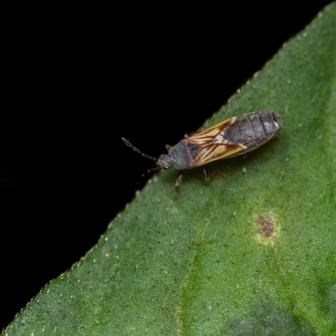Chinch Bugs
Chinch Bug is a general description of several species of small insects in the genus Blissus that can be damaging to turfgrass throughout the U.S. There are four relevant species of concern:
- Common chinch bug (Blissus leucopterus leucopterus)
- Hairy chinch bug (Blissus leucopterus hirtus)
- Southern chinch bug (Blissus insularis)
- Western chinch bug (Blissus occidus)

These insects can damage cool season turfgrasses such as bluegrass, fescues, bentgrass and ryegrass. They also damage warm season grasses – particularly St. Augustinegrass but also zoysiagrass and Bermudagrass. Different species are found in different geographical areas.
Chinch bugs are very small – up to 0.2 inches long adults and smaller nymphs. They are typically not noticeable in turf by the naked eye. There are diagnostic methods that can identify and isolate them – making them somewhat visible and countable.
Two generations usually occur each year. Adults overwinter until spring soil temperatures reach 50°F. Then the adults disperse, mate, and the females start laying eggs (which continues their full adult life). An adult female may produce an average of 300 eggs over 40 to 50 days. The eggs hatch in 1 - 2 weeks, and mature into adults over a period of 4 - 6 weeks. The new adults lay eggs from mid-July through late August. Second generation nymphs hatch and develop in September and October. When the colder weather arrives, adults seek overwintering sites in areas of leaf litter and dense thatch areas that are somewhat sheltered.
Chinch bugs prefer sunny areas, high levels of thatch and hot, dry weather. Damage from their feeding will be in these areas - causing the grass to first turn yellow, then reddish brown, and eventually die. Chinch bug damaged areas often coalesce into large patches of dead, brown grass.
Insecticides can control or suppress nymphs and adults throughout the summer when they are actively feeding on turfgrass. LebanonTurf offers several products that are labeled to control or suppress chinch bug populations, including the following:
- Bifenthrin – with fertilizer and on inert granules
- Allectus – with fertilizer
- Acelepryn – with fertilizer (suppression only)
- Merit – with fertilizer (suppression only)
- Imidacloprid + Lambda-cyhalothrin – with fertilizer
- Sevin (carbaryl) – on inert granules
Consider these products to control Chinch Bugs:
ProScape 16-0-8 30% MESA .225 Allectus
Lebanon Pro 17-0-3 40% PCU 3% Fe Imidacloprid + Lambda
Other options can be found in our insecticide product category
All products are applied with a dry granule spreader. General application timing is May through September. In general, smaller chinch bug nymphs are easier to control than mature adults. Follow all specific label directions when using these products.